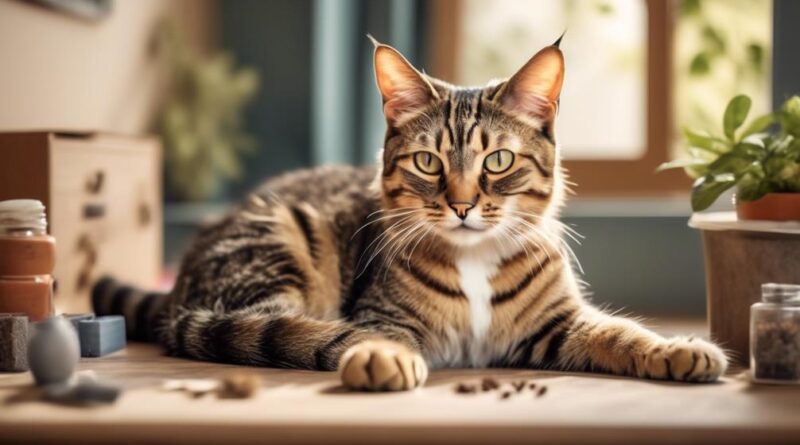Understanding the Factors Affecting Cat Behavior
Did you know that domestic cats spend an average of 15 hours a day resting or sleeping? Understanding the factors that affect cat behavior can not only help you build a stronger bond with your feline friend, but also ensure their overall well-being and happiness.
From genetics and breed to environmental enrichment, socialization, and health considerations, there are numerous elements that influence how cats behave. By exploring these factors, you can gain valuable insights into your cat's behavior and learn how to create a supportive environment that meets their specific needs.
Genetics and Breed
Understanding your cat's behavior starts with recognizing that genetics and breed play a significant role in shaping their personality and characteristics. Different cat breeds have distinct genetic predispositions that influence their behavior and temperament. These breed characteristics aren't just stereotypes but are actually rooted in genetic differences that have been selectively bred over generations.
Genetic predispositions can also affect a cat's activity level, grooming habits, and even their likelihood of developing certain health issues. For instance, the Persian breed is known for its long, luxurious coat, which requires regular grooming due to its genetic predisposition for excessive hair growth. On the other hand, breeds like the Abyssinian are known for their high energy levels and love for play, reflecting their genetic predisposition for activity.
Understanding your cat's breed characteristics can help you anticipate and address certain behaviors. By knowing your cat's genetic predispositions, you can provide them with an environment that meets their specific needs. For example, if you have a breed known for its high energy levels, you can ensure they've plenty of toys and opportunities for play.
Recognizing and understanding the influence of genetics and breed on your cat's behavior can lead to a deeper bond and a more fulfilling companionship.
Environmental Enrichment
To provide your cat with a stimulating environment, consider incorporating various toys and activities that encourage natural behaviors and mental stimulation. Environmental enrichment plays a crucial role in maintaining your cat's overall well-being.
Play therapy is an effective way to engage your cat in physical and mental activities. Interactive toys like feather wands, puzzle feeders, and laser pointers can encourage exercise and mental stimulation. These toys mimic hunting behaviors, keeping your cat entertained and mentally engaged.
Additionally, incorporating vertical spaces such as cat trees, shelves, and window perches can provide opportunities for climbing and observing their surroundings, which are natural feline behaviors.
Behavioral modification can also be achieved through environmental enrichment. For example, if your cat exhibits destructive behaviors like scratching furniture, providing appropriate scratching posts and regularly rotating or introducing new toys can redirect their focus and prevent destructive habits.
Creating a stimulating environment can reduce stress and anxiety, leading to improved behavior and overall well-being for your cat.
Socialization and Early Experiences
Incorporating socialization and exposing your cat to positive early experiences plays a crucial role in shaping their behavior and overall well-being. Early socialization involves introducing your cat to various people, animals, experiences, and environments during their critical developmental period, typically between 2 to 7 weeks of age. This period is crucial for fostering positive social behaviors and reducing the likelihood of fear or aggression towards unfamiliar stimuli later in life.
By providing early environmental exposure, such as different sounds, textures, and experiences, you can help your cat become more adaptable and less anxious in new situations.
Positive early experiences can have a lasting impact on your cat's behavior, influencing their ability to cope with stress, form social bonds, and adapt to changes in their environment. Cats that have been well-socialized and exposed to a variety of stimuli during their early developmental stages are often more confident, sociable, and less likely to exhibit problem behaviors such as aggression or excessive fearfulness.
It's important to note that while early socialization is crucial, cats of all ages can benefit from continued exposure to new experiences and environments. Providing environmental enrichment and positive social interactions throughout your cat's life can help maintain their behavioral flexibility and overall well-being.
Health and Medical Conditions
Ensuring your cat receives regular veterinary check-ups and prompt medical attention for any health issues is essential for maintaining their well-being and behavior. Behavior problems in cats can often be linked to underlying health or medical conditions. Behavioral changes such as increased aggression, excessive vocalization, or sudden withdrawal may be indicative of pain, discomfort, or illness. It's crucial to be attentive to these changes and seek professional veterinary care promptly.
Several health factors can influence cat behavior. Pain from conditions such as arthritis, dental issues, or injuries can lead to irritability or aggression. Similarly, urinary tract infections or gastrointestinal problems may cause a cat to become more irritable or exhibit changes in litter box habits. Additionally, thyroid imbalances, diabetes, or kidney disease can manifest in altered behavior patterns. Regular check-ups can help to identify and address these health issues before they significantly impact your cat's behavior and well-being.
Furthermore, it's important to note that certain medications or treatments for medical conditions can also affect your cat's behavior. For example, pain medications or steroids may cause changes in appetite, activity levels, or mood. It's advisable to discuss potential behavioral side effects with your veterinarian when initiating any new treatment.
Diet and Nutrition
Consider adjusting your cat's diet and nutrition to address specific behavioral issues and promote overall well-being. Your cat's food preferences and digestive health can significantly impact its behavior. Here are some important factors to consider when it comes to your feline friend's diet and nutrition:
- Food Preferences: Just like humans, cats have their own food preferences. Pay attention to the types of food your cat enjoys and observe how it affects their behavior. Some cats may prefer wet food over dry food, while others may have specific protein preferences. Adapting their diet to their preferences can contribute to a happier and more contented demeanor.
- Digestive Health: Digestive issues can lead to discomfort and irritability in cats. Ensure that your cat's diet supports good digestive health. This can involve feeding them high-quality, easily digestible food and providing access to fresh water at all times.
- Nutrient Balance: A well-balanced diet is crucial for your cat's overall well-being. Ensure that their food provides the necessary nutrients, including proteins, fats, vitamins, and minerals. A properly balanced diet can positively impact your cat's energy levels and behavior.
- Feeding Schedule: Establishing a consistent feeding schedule can help regulate your cat's behavior. Cats thrive on routine, and feeding them at the same times each day can create a sense of predictability and security.
Human-Cat Bond
Your cat's diet and nutrition play a significant role in strengthening the bond between you and your feline companion. Providing high-quality food and ensuring that your cat's nutritional needs are met can lead to a healthier and more vibrant relationship with your pet.
Just like in human relationships, communication cues are essential in understanding your cat's needs and emotions. Cats communicate through body language, vocalizations, and even facial expressions. Understanding these cues can help you respond to your cat's needs, which in turn can strengthen the bond between you and your feline friend.
Attachment theory also plays a crucial role in the human-cat bond. Cats can form strong emotional attachments to their human caregivers. By providing a secure and loving environment, you can foster a deep sense of security and trust in your cat. Spending quality time with your cat, engaging in interactive play, and offering affection can help reinforce this attachment.
Cats often seek out their human companions for comfort and security, demonstrating the strength of the bond formed through attachment.
Stress and Anxiety

Cats often display signs of stress and anxiety in response to various environmental and situational factors. As a cat owner, it's important to recognize these signs and take steps to help your feline companion feel more comfortable and secure.
Here are some tips to help reduce stress and anxiety in your cat:
- Behavioral Therapy: Just like humans, cats can benefit from behavioral therapy. This may involve creating a positive environment, establishing routines, and providing mental stimulation through interactive toys and puzzles.
- Calming Techniques: Implement calming techniques such as providing a quiet and safe space for your cat to retreat to when feeling stressed. Gentle petting and soothing verbal reassurance can also help alleviate anxiety.
- Feline Pheromones: Consider using feline pheromone products, such as diffusers, sprays, or collars, to help reduce stress. These synthetic pheromones mimic natural cat pheromones, creating a sense of security and comfort for your cat.
- Stress Reduction: Identify and eliminate sources of stress in your cat's environment. This could include minimizing exposure to loud noises, introducing new changes gradually, and ensuring your cat has access to hiding spots or elevated perches.
Routine and Schedule
As you address stress and anxiety in your cat, establishing a consistent routine and schedule can contribute significantly to their overall well-being and sense of security. Cats thrive on predictability, and having a set schedule for feeding, playtime, and rest can help reduce stress and anxiety.
Behavior modification and training methods can be implemented more effectively when your cat knows what to expect from their daily routine. Incorporating behavior modification techniques into your cat's routine can help address any existing behavioral issues and promote positive behaviors. By consistently reinforcing desired behaviors through training methods such as clicker training or positive reinforcement, you can encourage a sense of structure and stability for your cat.
Incorporating playtime and interactive activities into their daily schedule can also provide mental stimulation and physical exercise, contributing to a more balanced and contented feline companion. Additionally, maintaining a regular schedule for feeding and mealtimes can help regulate your cat's digestive system and reduce the likelihood of stress-related eating problems. Cats often feel more secure and relaxed when they know when to expect their meals.
Frequently Asked Questions
How Can I Help My Cat Adjust to a New Baby in the Household?
To help your cat adjust to a new baby, create a safe space for your feline friend, maintain their routine, and gradually introduce them to the baby. By doing so, you can alleviate feline anxiety and facilitate a smooth transition in the new family dynamics.
What Are Some Effective Ways to Introduce a New Cat to a Resident Cat?
When introducing a new cat to your resident cat, start slow. Allow them to smell each other's scents before meeting face-to-face. Gradually increase their time together, offering treats and positive reinforcement to encourage good behavior adjustment.
Is It Possible to Train a Cat to Walk on a Leash or Use a Litter Box?
Yes, you can train a cat to walk on a leash and use a litter box. Positive reinforcement and patience are key. Use harness training and gradually introduce the litter box alternatives to encourage successful training.
What Are Some Signs That My Cat May Be Experiencing Grief or Sadness After the Loss of a Companion Animal?
If your cat is experiencing grief after losing a companion, look for signs like changes in appetite or behavior. Comfort your cat by providing extra attention and creating a safe, comforting environment.
Are There Specific Techniques for Helping a Shy or Fearful Cat Become More Confident and Sociable?
To help your shy or fearful cat become more confident and sociable, consider building confidence through positive reinforcement, gradual exposure to new experiences, and creating a safe, comfortable environment. Socialization techniques include interactive play and gentle, patient interactions.
Conclusion
Understanding the factors that affect cat behavior is crucial for providing the best care for your feline friend. From genetics and breed to environmental enrichment and socialization, each aspect plays a role in shaping your cat's behavior.
By considering these factors and making adjustments as needed, you can create a happy and harmonious environment for your cat to thrive in.
Remember, a little understanding goes a long way in strengthening the bond between you and your furry companion.
